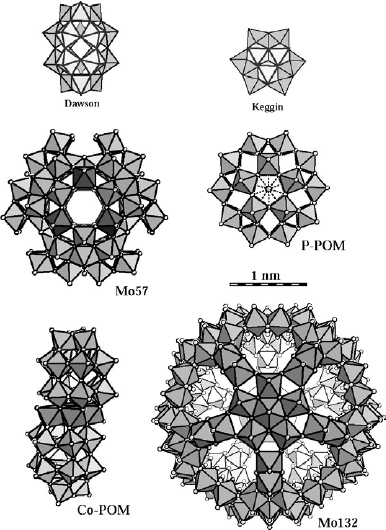Figure 23.

Structures of some of the POMs used for the fabrication of LbL multilayers. Keggin: [XM12O40]3−/4− (X=P, Si, M=W, Mo). Dawson: [P2M18O62]6− (M=W, Mo). Preyssler (P-POM): [M(H2O)P5W30O112]14/12− (M=Na, Eu). The P-POM has the shape of a flattened ellipsoid with dimensions 1.3×1.7 nm. Co-POM: [CoII4(H2O)2P4W30O112]16−. The ‘sandwich’ type Co(II)-substituted Co-POM is approximately 2.3 nm in length and 1.4 nm in width. Mo57: [H3Mo57V6(NO)6O183(H2O)18]21−. The external form of Mo57 is similar to that P-POM with dimensions of 1.6×2.4 nm. Mo132: giant Keplerate Mo132O372(CH3COO)30H2O)72]42−. The nearly spherical Mo132 with a diameter of approximately 3 nm shows promise for host–guest chemistry and size-selective catalysis because it possesses an open Mo–O framework architecture that encloses a central cavity with an approximate inner diameter of 1.7 nm. The Mo132 framework spans (Mo–O) 9-ring openings with an average ring aperture of 0.43 nm, which is comparable in size to pores in zeolitic architectures.
